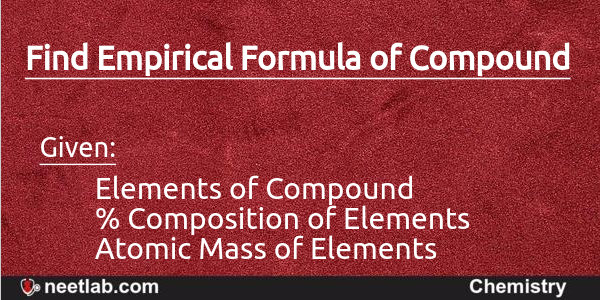| ⇦ | 
| ⇨ |
What Will Be Given: Percentage Composition of Each Element in The Compound
What To Calculate: Empirical Formula
Explanation :
The empirical formula of a compound is the minimum number of atoms required for each of its elements to form the bonding.
[lyte id=”_H009sTvYE0″ \]
Steps to Calculate:
- Get the mass of each element by assuming a certain overall mass for the sample (use 100 g as mass as it is easy to work with percentages).
- Find the moles for each element by using the atomic mass. Convert mass to moles.
- Find the element which has the smallest number of moles(T)
- Find the ratio or the moles of each element by dividing the number of moles of each by T(smallest number of moles identified in step 3).
- Write the empirical formula based on the ratios of each element.
Tips and Tricks:
- If the composition is missing for one element in the compound. Use 100 – (sum of other element’s composition) to find the missing element composition.
- When mole ratio obtained in step 4 contains decimal numbers. Do not round it off to nearest whole number, as it will lead to wrong answers.
- When mole ratio obtained in step 4 contains decimal numbers instead of whole numbers, a multiplication factor must be applied to get whole numbers for each element ratio. Refer example-1.
- The key to finding out the multiplication factors lies in considering making the decimal digits into the whole number. For example, in 1.334,334 is one-third of 1. Similarly, .5 is 1/2 of 1 and .2 are 1/5 of 1.
Example -1
A compound contains 48.38% carbon, 8.12% hydrogen, and 53.5% oxygen by mass. Find its empirical formula.
As per Step-1,
Mass of Carbon = 0.4838 x 100 g = 48.38 grams
Mass of Hydrogen = 0.0812 x 100 g = 8.12 grams
Mass of Oxygen = 0.535 x 100g = 53.5 grams
As per Step-2,
One mole of Carbon weighs 12.10 g(Atomic mass of Carbon)
X mole of Carbon weighs 48.38 gms
Moles of Carbon (X) = (48.38 g C) x 1 mol / 12.10 g C = 4.028 mol
One mole of Hydrogen weighs 1.008 g(Atomic mass of Hydrogen)
X mole of Hydrogen weighs 8 grams
Moles of Hydrogen (Y) = (8.12 g H) (1 mol/ 1.008 g H) = 8.056 mol
One mole of Oxygen weighs 16.00 g(Atomic mass of Oxygen)
X mole of Oxygen weighs 53.38 grams
Moles of Oxygen (Y) = (53.38 g O) (1 mol/ 16.00 g O) = 3.336 mol
As per Step-3,
the lowest number of moles is present in the oxygen
As per Step-4,
Ratio of Carbon = 4.028/3.336 = 1.2
Ratio of Hydrogen = 8.056/3.336 = 2.4
Ratio of Oxygen = 3.336/3.336 = 1
As per Tips and Tricks-2,
The least factor to be multiplied is 5 to get all the above ratios to the whole number.
(1 mol O) (5) = 5 mol O
(1.2 mol C) (5) = 6 mol C
(2.4 mol H) (5) = 12 mol H
As per Step-6,
Empirical Formula = C₆H₁₂O₅
Related Questions
- A bromoalkane contains 35% carbon and 6.57% hydrogen by mass. Calculate the empirical
- An organic compound containing C, H and O gave the following analysis
- The weight of one molecule of a compound C₆₀H₁₂₂ is
Subject: Chemistry (2512)
Important MCQs Based on Medical Entrance Examinations To Improve Your NEET Score
18000+ students are using NEETLab to improve their score. What about you?
Solve Previous Year MCQs, Mock Tests, Topicwise Practice Tests, Identify Weak Topics, Formula Flash cards and much more is available in NEETLab Android App to improve your NEET score.
Share this page with your friends

Leave a Reply